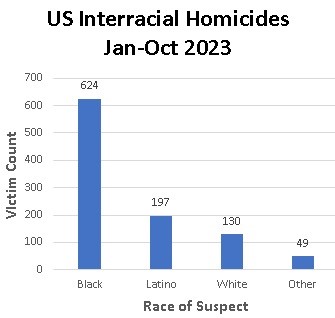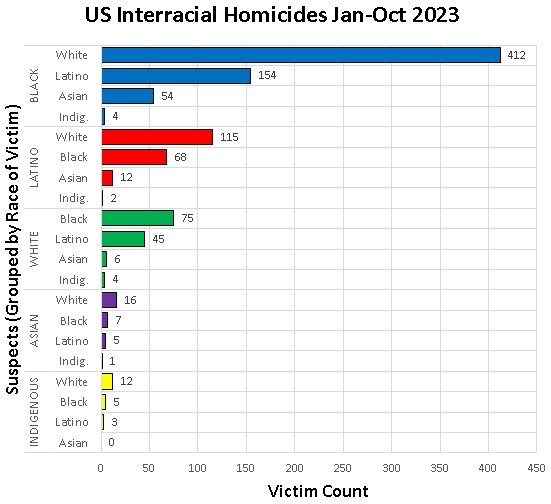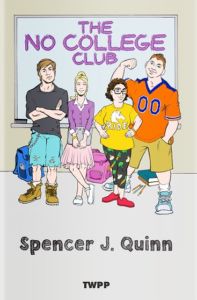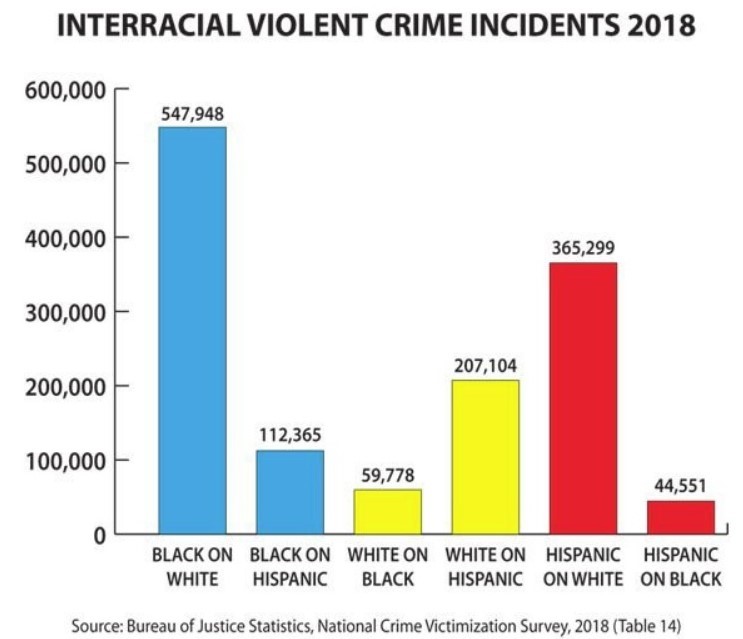A strong sense of victimhood might not come naturally to the majority of whites in the West, but if they wish to compete politically with non-whites as the demographic winds keep blowing against them, it had better start coming naturally — and soon. Victimhood, however, should never be mistaken for victim status. The former is the perfectly moral and rational understanding that at any given point in history one’s people could be attacked, subjugated, decimated, or even destroyed by outgroup members. The latter, however, is an opportunistic scam in which a group uses history as a pretext to acquire resources or privileges which they have no intention of earning. The former is a source of strength and vigilance; the latter a sign of weakness and corruption.
This thought occurred to me while reading a recent post from National Conservative which compiled the first 1,000 cases of interracial homicide in the United States this year. As expected, the racial breakdown of the suspects perfectly coincided with the findings presented in Edwin Rubinstein’s 2016 report The Color of Crime. Blacks, who make up 13.6% of the population of the United States, made up 62.4% of the suspects. Hispanics, who make up 19.1% of the population, made up 19.7% of the suspects. And whites, who make up 58.9% of the population, made up 13% of the suspects.

Source: National Conservative, “We have examined 1,000 confirmed interracial homicides in 2023 so far,” November 3, 2023.
Such statistics are important for bolstering race realism as well as a healthy sense of self-preservation. After all, anyone of any race can be a victim of a crime if he’s careless enough. Knowing the realities of race can help keep one alive. Sam Collington, Thomas Hand, Tyler Wingate, and Adam Simjee each ignored black-white racial differences and paid the ultimate price for it. To counteract this, John Derbyshire said the quiet part out loud in 2012 with his TakiMag essay “The Talk (The Non-Black Version),” which promptly got him fired from National Review. In it he offers a template for how to discuss race with one’s children, with the basic message being that blacks as a group typically do not adhere to the higher standards of civilized behavior to which most non-blacks adhere. Thus, blacks are dangerous, and, unless one knows a particular black personally, should be treated with the greatest of caution.
This is all well and good, of course, but it is only half the story. The National-Conservative post has the additional value of presenting the races of the victims (as well as a monthly breakdown of interracial homicides). And here is where white victimhood comes in. Of the thousand victims tallied, 555, or 55.5% were white. Blacks were responsible for 412 of these deaths, and Latinos 115. Below is the complete breakdown, in which the Indigenous category comprises American Indian, Alaskan Native, and Pacific Islander groups, and the Asian category comprises East Asian, Central Asian, and Middle Eastern groups, as laid out by National Conservative:

Source: National Conservative, “We have examined 1,000 confirmed interracial homicides in 2023 so far,” November 3, 2023.
Of course, given that American whites still form an absolute majority, it makes sense that they would occupy the largest victim category for every group of non-white suspects. More whites get killed because there are more of them available to be killed. Proximity probably has something to do with it as well. But this alone cannot possibly explain the high numbers coming from blacks, whose proportion of the population likely dips to around 13.3% once you exclude the ones already incarcerated.
Regardless, whites suffer the most from racial diversity. It is exactly this kind of suffering that Reconstruction-era whites wished to mitigate or avoid through Jim Crow laws and racial segregation, and in areas of the country where we had a lot of blacks, it worked. According to Stephan and Abigail Thernstrom in their 1997 study America in Black and White, crime rates were lower when Jim Crow laws and segregation were in effect:
The rate of violent crime in the United States rose by 25 percent between 1960 and 1965, enough to produce real public worry. Over the next five years, violent crime jumped by a stunning 82 percent. African Americans — especially young black males — were responsible for far more than their share of the increase (and were overrepresented among the victims). The rate at which blacks were arrested on homicide charges, for example, tripled in the course of the 1960s, while the white rate climbed only moderately.
Such relatively mild anti-black measures made life more peaceful and orderly for whites — and for blacks as well, as long as they respected white authority. Since whites were the creators and defenders of Western civilization and had an evolutionary head start over blacks measured in millennia, there was no reason for blacks not to — unless they wished to wield power themselves, to the detriment of everyone else. We saw this with the rampant crime and corruption of the Reconstruction period, and we are seeing it today in America, and especially in Haiti and post-colonial Africa. Blacks on average simply have not demonstrated the intellect and impulse control required to responsibly govern modern societies. When put in a position of governance, they invariably wreak havoc.
Of course, this havoc is avoidable through common sense race realism, which makes the deaths it causes all the more tragic. It also disproportionately impacts whites, and leads to an unreciprocated death count numbering in the tens of thousands. If we take the low estimate of the US black-on-white homicide rate to 400 per year since 1964 — the year the Civil Rights Act effectively dismantled racial segregation — that will leave us with approximately 23,600 whites murdered by blacks by the end of 2023.
This alone is cause for white victimhood and a strong sense of grievance against blacks.
Throw in how whites are the disproportionate victims of violent interracial non-homicidal crime, to the tune of hundreds of thousands every year, and this sense of victimhood only crystalizes further. In 2018 that number was 913,247: 547,948 caused by blacks, and 365,299 caused by Latinos. In terms of interracial victimhood, no other racial group in America comes close.

You can buy Spencer J. Quinn’s young adult novel The No College Club here.
I recently read a book about the 1921 Tulsa, Oklahoma race riot called The Burning by journalist Tim Madigan. I found it to be a well-researched but callously one-sided piece of black victim-mongering, and I bring it up to demonstrate how far white victimhood outstrips black victimhood in the United States.
Madigan offers lips service to the white perspective on the riots while championing the black one. As the story goes, a number of militant blacks from Tulsa’s Greenwood district, who were outraged over the white supremacist nature of the establishment in Oklahoma, decided to protect a young black who had been incarcerated for allegedly attacking a white girl in an elevator. Thanks to a recklessly inflammatory editorial by white newspaper publisher Richard Lloyd Jones and an angry (yet mostly unarmed) crowd of whites gathering at the Tulsa courthouse, several dozen armed-to-the-teeth blacks showed up to prevent the black suspect from getting lynched. The whites quite reasonably saw this as a threat and quickly armed themselves, even to the point of raiding the nearby National Guard Armory. The Sheriff, who was competently protecting the suspect, had calmed the blacks and sent them back across the tracks to Greenwood. But they soon returned with greater numbers.
Here is where things get hazy. Apparently, an older white man had tried to disarm one of the leading blacks, and the latter’s gun accidentally went off. Yet, a key black witness named O. W. Gurley later testified at the grand jury investigation that the blacks had fired against the whites first. In either case, bedlam ensued. With veterans of the First World War on both sides, the melee soon resembled organized warfare. With greater numbers and resources, the whites ultimately prevailed and forced the surviving blacks to flee or surrender. The next day, in a mass act of malicious cruelty, an angry, determined mob of whites razed Greenwood to the ground. Read more about the Tulsa riots from Counter-Currents’ own Robert Hampton here.
An Oklahoma commission in 2001 confirmed that there had been 38 deaths, 13 of which were white, in the Tulsa race riot, but speculated from anecdotal evidence that the real count could be as high as 300 –or as low as 300, given that blacks have already killed 137% of that number of whites this year alone. Today there are many books commemorating the Tulsa race riot — or “massacre,” as it is now called — but none seem to acknowledge the high rates of violent crime blacks commit wherever they go, and how this might have led to the whites’ frustration to begin with.
Madigan gives us a clue, and unfortunately that is about all he gives:
The devil was busy on some of those Greenwood streets. There was no denying that. Prostitutes beckoned from the bawdy houses along First Street and Admiral Drive. Seedy men and women comingled in shacks in the alleys off Greenwood Avenue, drinking themselves into stupors with that cheap, milky-white intoxicant distilled from Choctaw root. The state’s heroin traffic was said to originate from a shack in Greenwood, too. Many young men were idle and troublesome.
This describes the so-called “Black Wall Street” of Tulsa. Prior to the riot Tulsa had been afflicted with increased crime, as well as “a series of local jailbreaks,” which had “inflamed” the city. Madigan doesn’t specify the criminals’ race but, given the universal black criminality we know today, is it really so much of a leap to presume that “idle and troublesome” blacks were disproportionately to blame? Is it really too much to presume that the post-Reconstruction blacks of Tulsa had been corrupted by freedom and biologically false notions of equality, which caused them to increasingly inflict their criminal behavior on white people?
Thomas Nelson Page, in his 1904 study The Negro: The Southerner’s Problem, claims as much, and has the figures to back it up. Murder aside, freed blacks had begun molesting white women at appalling rates during Reconstruction, and this did not let up during the twentieth century, despite Madigan’s unsupported claim that lynching victims’ sexual crimes were “more imagined than real.” From my review of Page’s work:
As much as he despised lynching, Page assumes the difficult burden of arguing that it was Negro criminal and sexual misbehavior (or “ravishings”, as he calls it) which prompted much of that deadly practice. In the chapter entitled “The Lynching of Negroes — Its Cause and Its Prevention,” he offers a history of lynching and then provides a table from the Chicago Tribune which lists the causes assigned to the 450 lynchings which occurred from 1900 to 1903. Roughly eighty percent of the 450 victims from 1900 to 1903 were Negroes. 171 (or thirty-eight percent) of the lynchings were caused by murder or attempted murder, while 102 (or twenty-three percent) were the result of rape or attempted rape. (There was one caused by “rape and murder” which I counted among the murders.) An additional 18 (four percent) were the result of complicity in murder or aiding the escape of a murderer. Counter to the modern understanding which paints Negro victims of lynchings as innocent martyrs, there were only 68 cases, or fifteen percent, within this four-year span wherein a person was lynched merely for being suspected of a crime, for doing something offensive yet not illegal, for unknown reasons, or for no reason at all. This was still reprehensible, of course, but perhaps less so when considered within a more complete understanding of the historical context.
Thus, when the news broke that yet another black man may have assaulted yet another white woman, of course the whites responded with anger and alarm.
After the riot Jones published another editorial which differentiated the good Negro who is “kind and courteous” from the bad Negro, who
. . . drinks the cheapest and the vilest whiskey. He breaks every law to get it. He is a dope fiend. He holds life lightly. He is a bully and a brute.
Given that since January blacks have murdered 412 whites, 212 additional non-blacks, and probably over a thousand of their own, exactly how is Jones’ assessment incorrect?
Madigan also demonstrates the fact that the Greenwood blacks were just itching for an armed confrontation with the Tulsa whites. One black leader promised that
[t]he day a member of our group is mobbed in Tulsa, the streets will be bathed in blood. . . . If I can’t get anyone to go with me, I will go singlehanded and empty my automatic into the mob and then resign myself to my fate.
Madigan writes:
But back in Greenwood, the Negro fury had escalated beyond anything one man could hope to diffuse. Greenwood’s leaders had dispatched messengers to every corner of the Negro quarter, putting out the call for men and arms, and volunteers arrived every minute, singly and in groups, carrying rifles, pistols, shotguns, garden hoes, rakes, and axes. Young men came with the old, rich men with the poor. As he turned onto Greenwood Avenue, Gurley was forced to dodge a succession of speeding touring cars, with Negro men packed inside and hanging from running boards, yelling and firing their weapons into the night.
This is what passes for black victimhood these days: anywhere from 26 to 300 deaths resulting from a fight that blacks themselves had helped instigate, all to protect someone who may have been guilty of assault and didn’t need protecting in any case. How have things changed a century later? Known felon George Floyd died of a fentanyl overdose while behaving erratically in police custody after passing phony bills, and then blacks everywhere rioted and burned cities — all out of a misplaced sense of victimhood.
Meanwhile, these very same blacks murder hundreds of whites every year, leading to very little outrage or protest. This will continue until American whites not only assume a sense of victimhood themselves, but also realize that according to US crime statistics, their victimhood outstrips anyone else’s.

Enjoyed this article?
Be the first to leave a tip in the jar!
* * *
Counter-Currents has extended special privileges to those who donate at least $10/month or $120/year.
- Donors will have immediate access to all Counter-Currents posts. Everyone else will find that one post a day, five posts a week will be behind a “paywall” and will be available to the general public after 30 days. Naturally, we do not grant permission to other websites to repost paywall content before 30 days have passed.
- Paywall member comments will appear immediately instead of waiting in a moderation queue. (People who abuse this privilege will lose it.)
- Paywall members have the option of editing their comments.
- Paywall members get an Badge badge on their comments.
- Paywall members can “like” comments.
- Paywall members can “commission” a yearly article from Counter-Currents. Just send a question that you’d like to have discussed to [email protected]. (Obviously, the topics must be suitable to Counter-Currents and its broader project, as well as the interests and expertise of our writers.)
To get full access to all content behind the paywall, please visit our redesigned Paywall page.


1 comment
America was designed to be a white country. Our founders congratulated themselves for that intended system and could not imagine that Americans might eventually opt for demographic suicide. I can remember when our country was 90% white, a utopian dispensation apart from the other 10%.
Comments are closed.
If you have Paywall access,
simply login first to see your comment auto-approved.
Note on comments privacy & moderation
Your email is never published nor shared.
Comments are moderated. If you don't see your comment, please be patient. If approved, it will appear here soon. Do not post your comment a second time.